gear shi MITSUBISHI COLT 2009 10.G Owners Manual
[x] Cancel search | Manufacturer: MITSUBISHI, Model Year: 2009, Model line: COLT, Model: MITSUBISHI COLT 2009 10.GPages: 273, PDF Size: 17.28 MB
Page 7 of 273
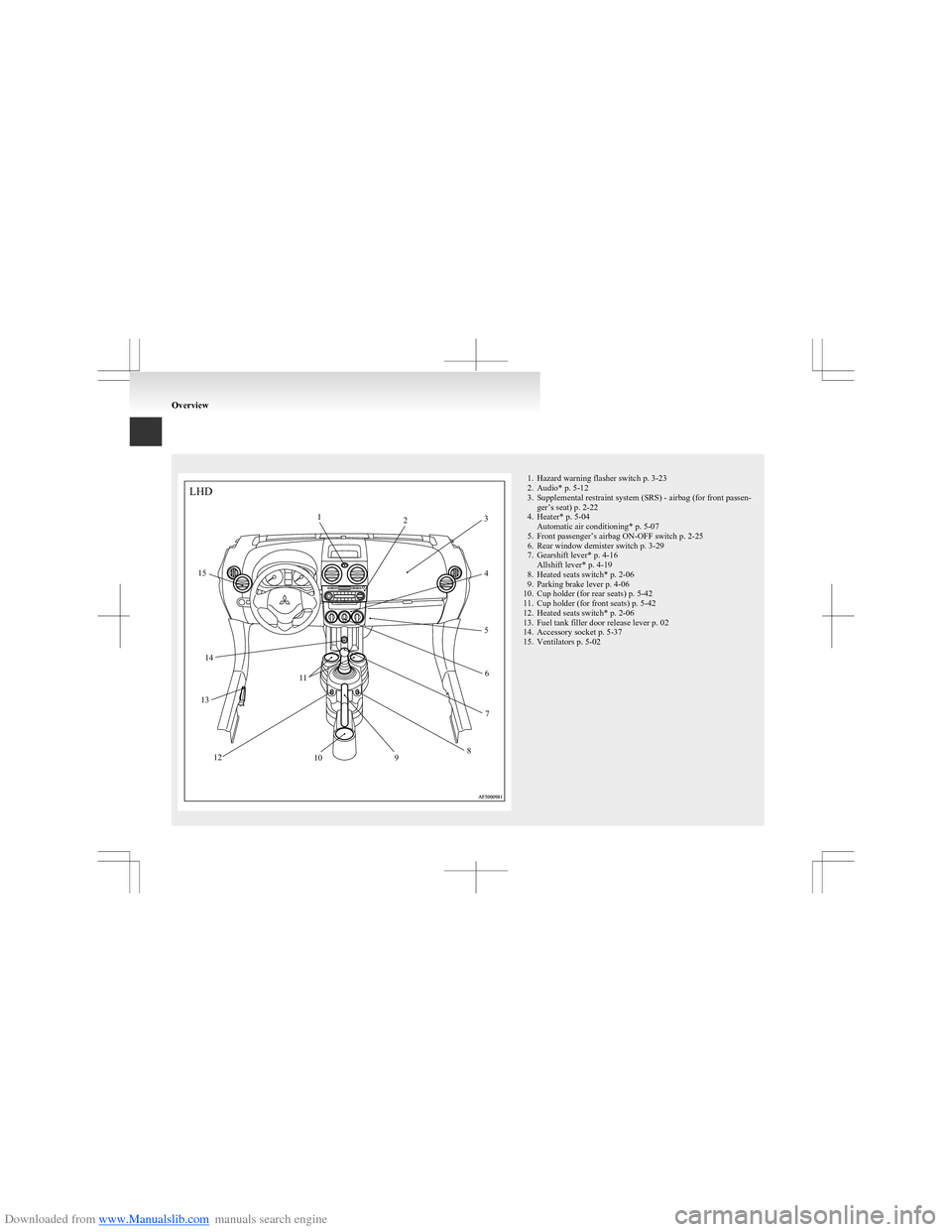
Downloaded from www.Manualslib.com manuals search engine 1. Hazard warning flasher switch p. 3-23
2. Audio* p. 5-12
3. Supplemental restraint system (SRS) - airbag (for front passen- ger’s seat) p. 2-22
4. Heater* p. 5-04 Automatic air conditioning* p. 5-07
5. Front passenger’s airbag ON-OFF switch p. 2-25
6. Rear window demister switch p. 3-29
7. Gearshift lever* p. 4-16 Allshift lever* p. 4-19
8. Heated seats switch* p. 2-06
9. Parking brake lever p. 4-06
10. Cup holder (for rear seats) p. 5-42
11. Cup holder (for front seats) p. 5-42
12. Heated seats switch* p. 2-06
13. Fuel tank filler door release lever p. 02
14. Accessory socket p. 5-37
15. Ventilators p. 5-02
OverviewLHD123
4
5 67
8
9
10
12 11
13 14
15
Page 8 of 273
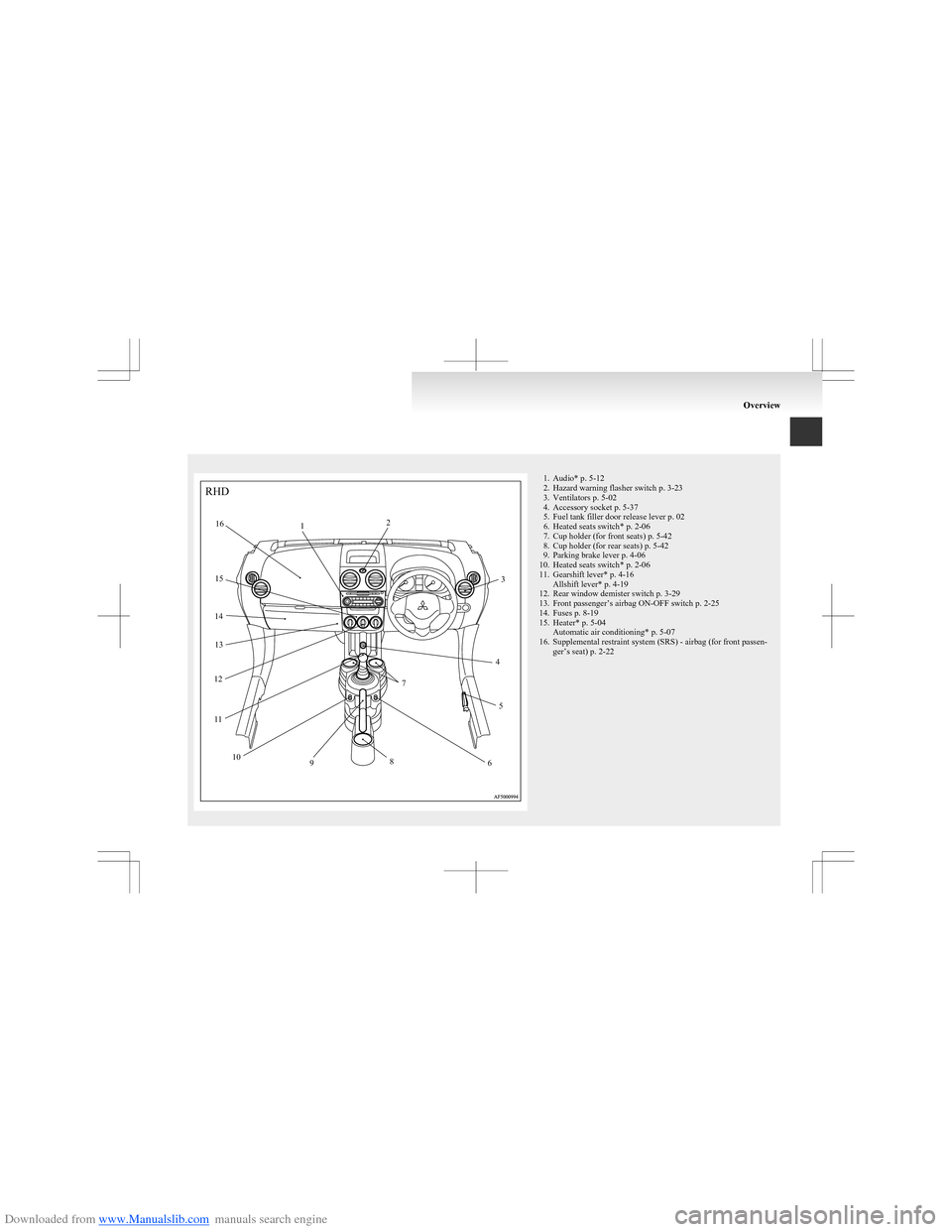
Downloaded from www.Manualslib.com manuals search engine 1. Audio* p. 5-12
2. Hazard warning flasher switch p. 3-23
3. Ventilators p. 5-02
4. Accessory socket p. 5-37
5. Fuel tank filler door release lever p. 02
6. Heated seats switch* p. 2-06
7. Cup holder (for front seats) p. 5-42
8. Cup holder (for rear seats) p. 5-42
9. Parking brake lever p. 4-06
10. Heated seats switch* p. 2-06
11. Gearshift lever* p. 4-16 Allshift lever* p. 4-19
12. Rear window demister switch p. 3-29
13. Front passenger’s airbag ON-OFF switch p. 2-25
14. Fuses p. 8-19
15. Heater* p. 5-04 Automatic air conditioning* p. 5-07
16. Supplemental restraint system (SRS) - airbag (for front passen- ger’s seat) p. 2-22
OverviewRHD12
3
4 5
6
8 7
9
10
11
12
13
14 15 16
Page 77 of 273
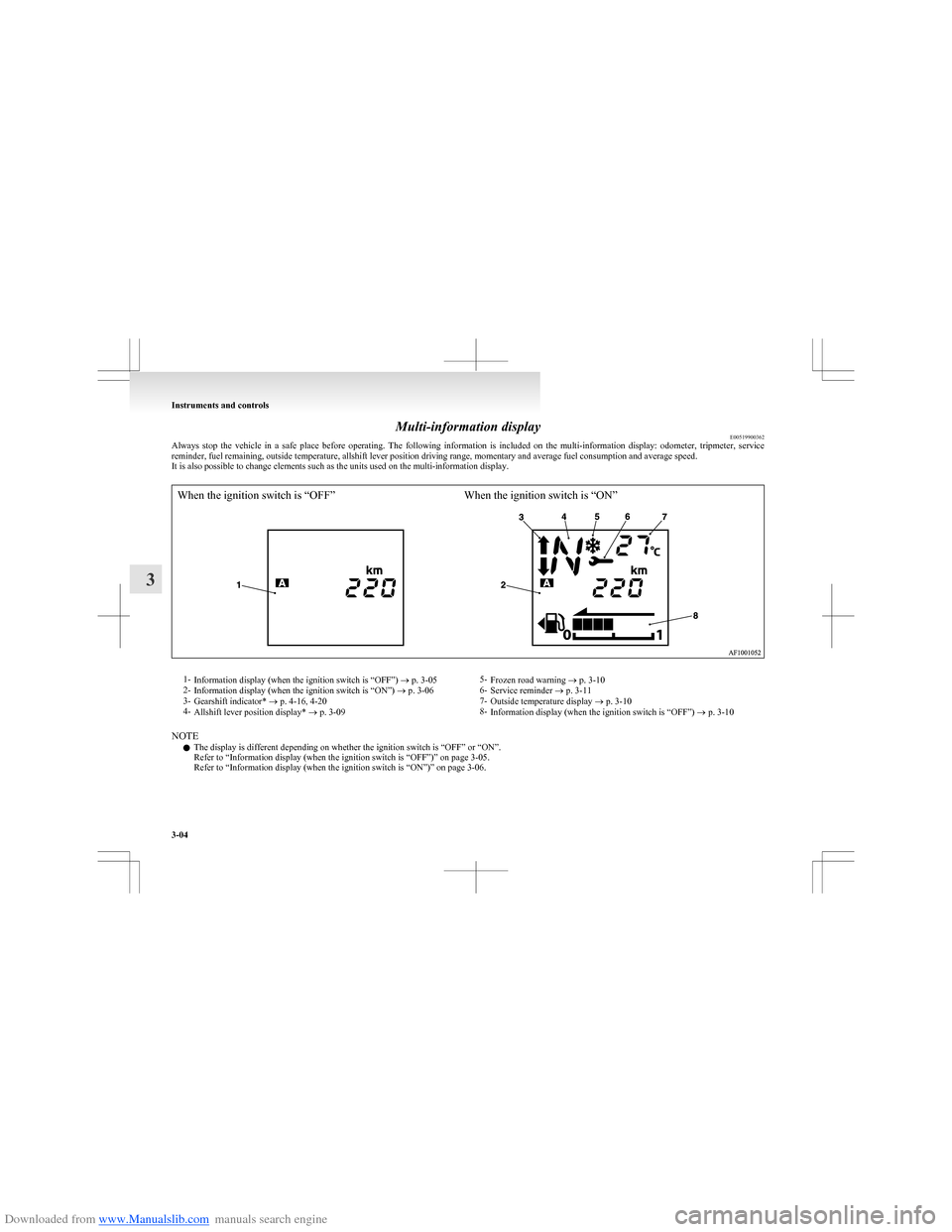
Downloaded from www.Manualslib.com manuals search engine Multi-information displayE00519900362
Always stop the vehicle in a safe place before operating. The following information is included on the multi-information display: odometer, tripmeter, service
reminder, fuel remaining, outside temperature, allshift lever position driving range, momentary and average fuel consumption and average speed.
It is also possible to change elements such as the units used on the multi-information display.
When the ignition switch is “OFF”When the ignition switch is “ON”1- Information display (when the ignition switch is “OFF”) ® p. 3-05
2- Information display (when the ignition switch is “ON”) ® p. 3-06
3- Gearshift indicator* ® p. 4-16, 4-20
4- Allshift lever position display* ® p. 3-095-
Frozen road warning ® p. 3-10
6- Service reminder ® p. 3-11
7- Outside temperature display ® p. 3-10
8- Information display (when the ignition switch is “OFF”) ® p. 3-10
NOTE
l The display is different depending on whether the ignition switch is “OFF” or “ON”.
Refer to “Information display (when the ignition switch is “OFF”)” on page 3-05.
Refer to “Information display (when the ignition switch is “ON”)” on page 3-06.
Instruments and controls
3-04
3
Page 83 of 273

Downloaded from www.Manualslib.com manuals search engine Outside temperature displayE00528400015
This displays the temperature outside the
vehicle.
NOTE l The display setting can be
changed to the preferred units ( °C
or °F).
Refer to “Changing the function
settings (when the ignition switch
is “ON”)” on page 3-12.
l The outside temperature can be dis-
played in a range of -40°C to 50°C
(-40°F to 122°F).
l Depending on factors such as the
driving conditions, the displayed
temperature may vary from the ac-
tual outside temperature.Frozen road warning E00528500016
If the outside air temperature drops be-
low approx. 3°C, the alarm sounds and
the outside air temperature warning sym-
bol flashes for about 10 seconds.CAUTIONl There is a danger the road
might be icy, even when this
symbol is not flashing, so please
take care when driving.Gearshift indicator* E00528600020
The gearshift indicator (if so equipped)
shows recommended gearshift points for
fuel-efficient driving.
Refer to “Changing gears” on page
4-17.
Refer to “Driving” on page 4-23.Fuel remaining display E00522200444
This displays the amount of fuel remaining.
CAUTIONlDo not run out of fuel, or the catalytic con-
verter may be adversely affected. If the
warning display appears, refuel as soon
as possible.
NOTE
l It may take several seconds to stabilise the
display after refilling the tank.
l If fuel is added with the ignition switch in
the “ON” position, the fuel gauge may incor-
rectly indicate the fuel level.Fuel lid mark E00522300038
The arrow (A) indicates that the fuel tank filler is
located on the left side of the body.
Fuel remaining warning display E00522400215
If the remaining fuel level is approximately 7 liters
or less (one segment displayed) when the ignition
switch is turned to the “ON” position, the last seg-
ment of the fuel gauge flashes. If the remaining
fuel level is approximately 4 liters or less (no seg-
ments displayed), “
” and the bar graph flash.
One segment is displayedNo segments are displayed
NOTE
l On inclines or curves, the display may be in-
correct due to the movement of fuel in the tank.
Instruments and controls
3-10
3
Page 105 of 273
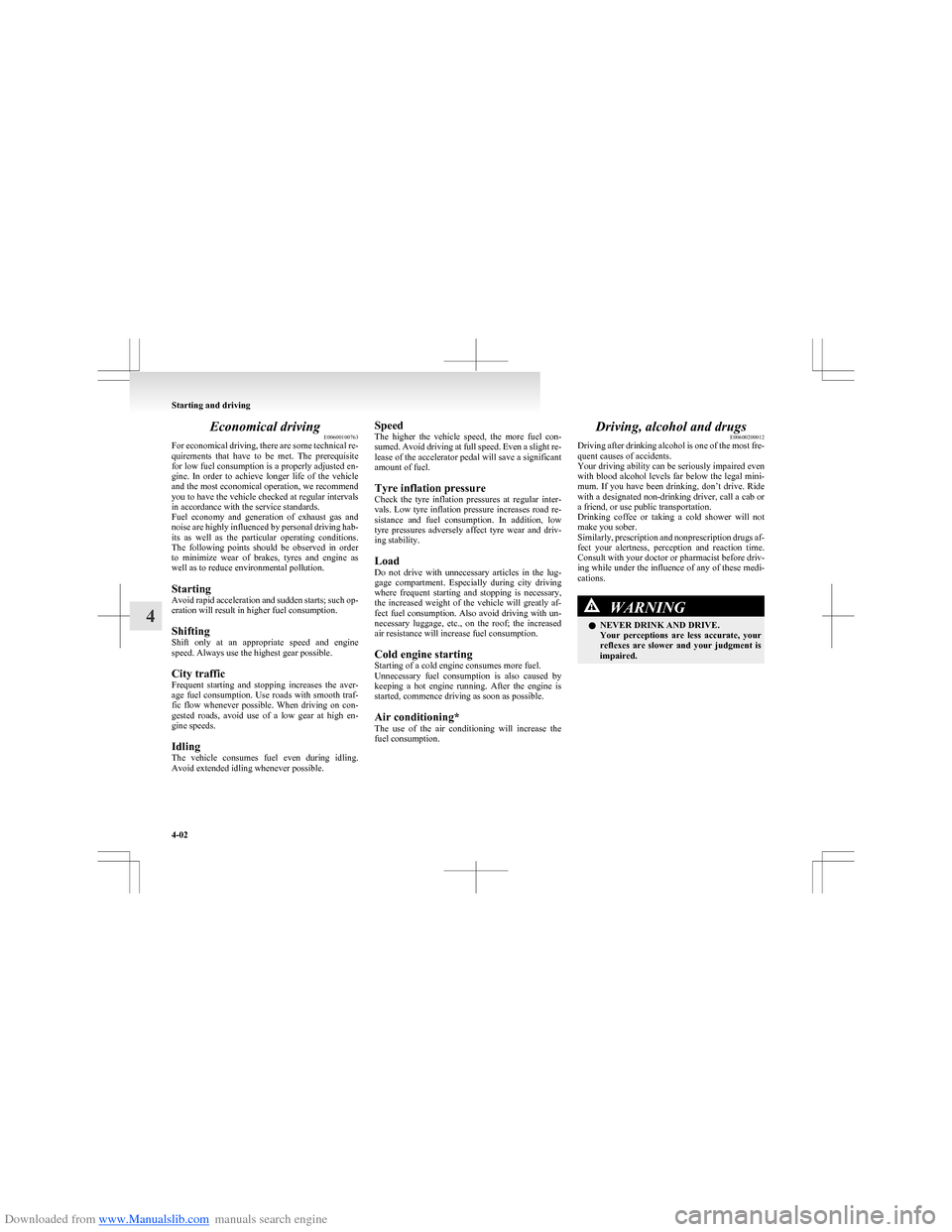
Downloaded from www.Manualslib.com manuals search engine Economical drivingE00600100763
For economical driving, there are some technical re-
quirements that have to be met. The prerequisite
for low fuel consumption is a properly adjusted en-
gine. In order to achieve longer life of the vehicle
and the most economical operation, we recommend
you to have the vehicle checked at regular intervals
in accordance with the service standards.
Fuel economy and generation of exhaust gas and
noise are highly influenced by personal driving hab-
its as well as the particular operating conditions.
The following points should be observed in order
to minimize wear of brakes, tyres and engine as
well as to reduce environmental pollution.
Starting
Avoid rapid acceleration and sudden starts; such op-
eration will result in higher fuel consumption.
Shifting
Shift only at an appropriate speed and engine
speed. Always use the highest gear possible.
City traffic
Frequent starting and stopping increases the aver-
age fuel consumption. Use roads with smooth traf-
fic flow whenever possible. When driving on con-
gested roads, avoid use of a low gear at high en-
gine speeds.
Idling
The vehicle consumes fuel even during idling.
Avoid extended idling whenever possible.Speed
The higher the vehicle speed, the more fuel con-
sumed. Avoid driving at full speed. Even a slight re-
lease of the accelerator pedal will save a significant
amount of fuel.
Tyre inflation pressure
Check the tyre inflation pressures at regular inter-
vals. Low tyre inflation pressure increases road re-
sistance and fuel consumption. In addition, low
tyre pressures adversely affect tyre wear and driv-
ing stability.
Load
Do not drive with unnecessary articles in the lug-
gage compartment. Especially during city driving
where frequent starting and stopping is necessary,
the increased weight of the vehicle will greatly af-
fect fuel consumption. Also avoid driving with un-
necessary luggage, etc., on the roof; the increased
air resistance will increase fuel consumption.
Cold engine starting
Starting of a cold engine consumes more fuel.
Unnecessary fuel consumption is also caused by
keeping a hot engine running. After the engine is
started, commence driving as soon as possible.
Air conditioning*
The use of the air conditioning will increase the
fuel consumption.Driving, alcohol and drugs E00600200012
Driving after drinking alcohol is one of the most fre-
quent causes of accidents.
Your driving ability can be seriously impaired even
with blood alcohol levels far below the legal mini-
mum. If you have been drinking, don’t drive. Ride
with a designated non-drinking driver, call a cab or
a friend, or use public transportation.
Drinking coffee or taking a cold shower will not
make you sober.
Similarly, prescription and nonprescription drugs af-
fect your alertness, perception and reaction time.
Consult with your doctor or pharmacist before driv-
ing while under the influence of any of these medi-
cations.WARNINGl NEVER DRINK AND DRIVE.
Your perceptions are less accurate, your
reflexes are slower and your judgment is
impaired.
Starting and driving
4-02
4
Page 107 of 273
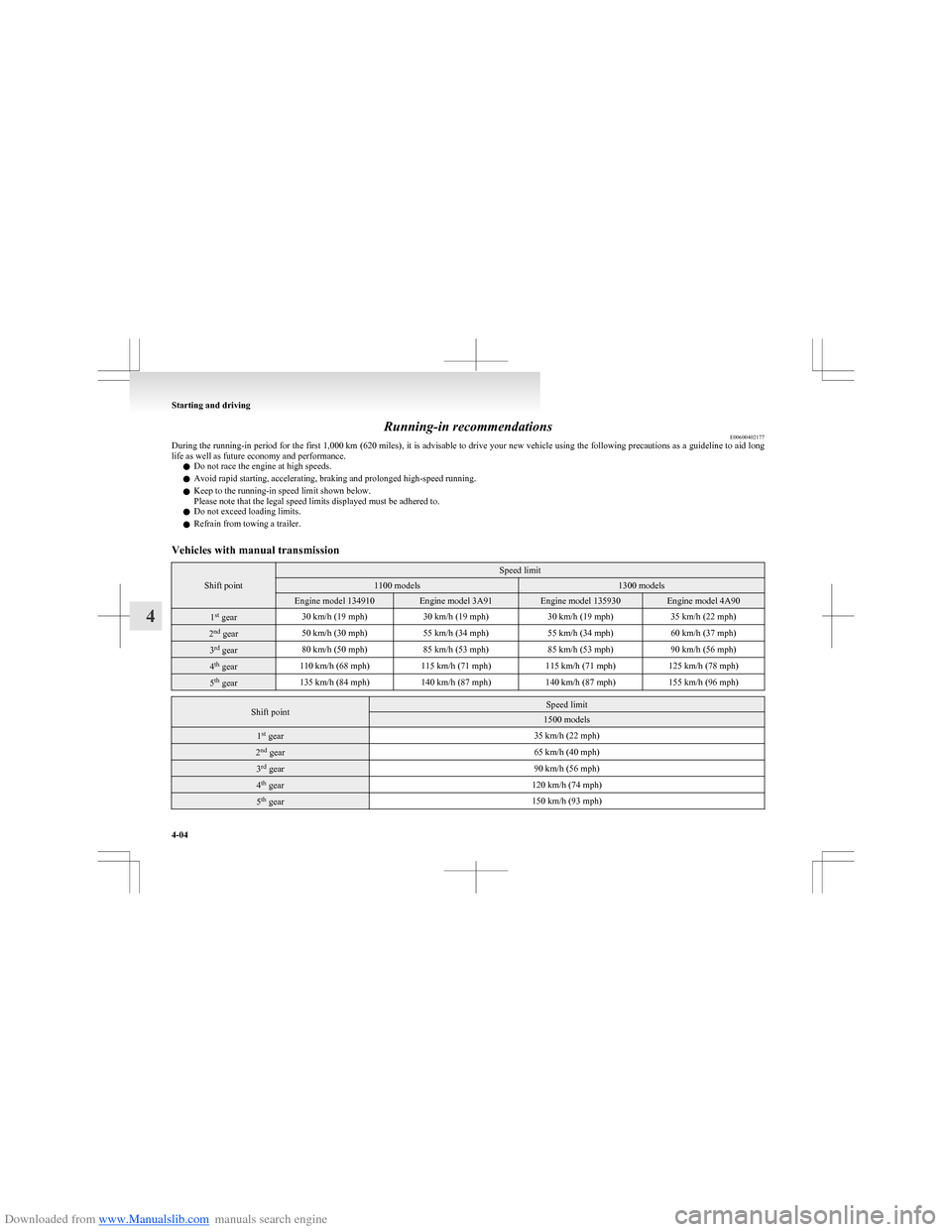
Downloaded from www.Manualslib.com manuals search engine Running-in recommendationsE00600402177
During the running-in period for the first 1,000 km (620 miles), it is advisable to drive your new vehicle using the following precautions as a guideline to aid long
life as well as future economy and performance.
l Do not race the engine at high speeds.
l Avoid rapid starting, accelerating, braking and prolonged high-speed running.
l Keep to the running-in speed limit shown below.
Please note that the legal speed limits displayed must be adhered to.
l Do not exceed loading limits.
l Refrain from towing a trailer.Vehicles with manual transmission
Shift point
Speed limit1100 models1300 modelsEngine model 134910Engine model 3A91Engine model 135930Engine model 4A901st
gear30 km/h (19 mph)30 km/h (19 mph)30 km/h (19 mph)35 km/h (22 mph)2nd
gear50 km/h (30 mph)55 km/h (34 mph)55 km/h (34 mph)60 km/h (37 mph)3rd
gear80 km/h (50 mph)85 km/h (53 mph)85 km/h (53 mph)90 km/h (56 mph)4th
gear110 km/h (68 mph)115 km/h (71 mph)115 km/h (71 mph)125 km/h (78 mph)5th
gear135 km/h (84 mph)140 km/h (87 mph)140 km/h (87 mph)155 km/h (96 mph)Shift pointSpeed limit1500 models1st
gear35 km/h (22 mph)2nd
gear65 km/h (40 mph)3rd
gear90 km/h (56 mph)4th
gear120 km/h (74 mph)5th
gear150 km/h (93 mph)
Starting and driving
4-04
4
Page 108 of 273
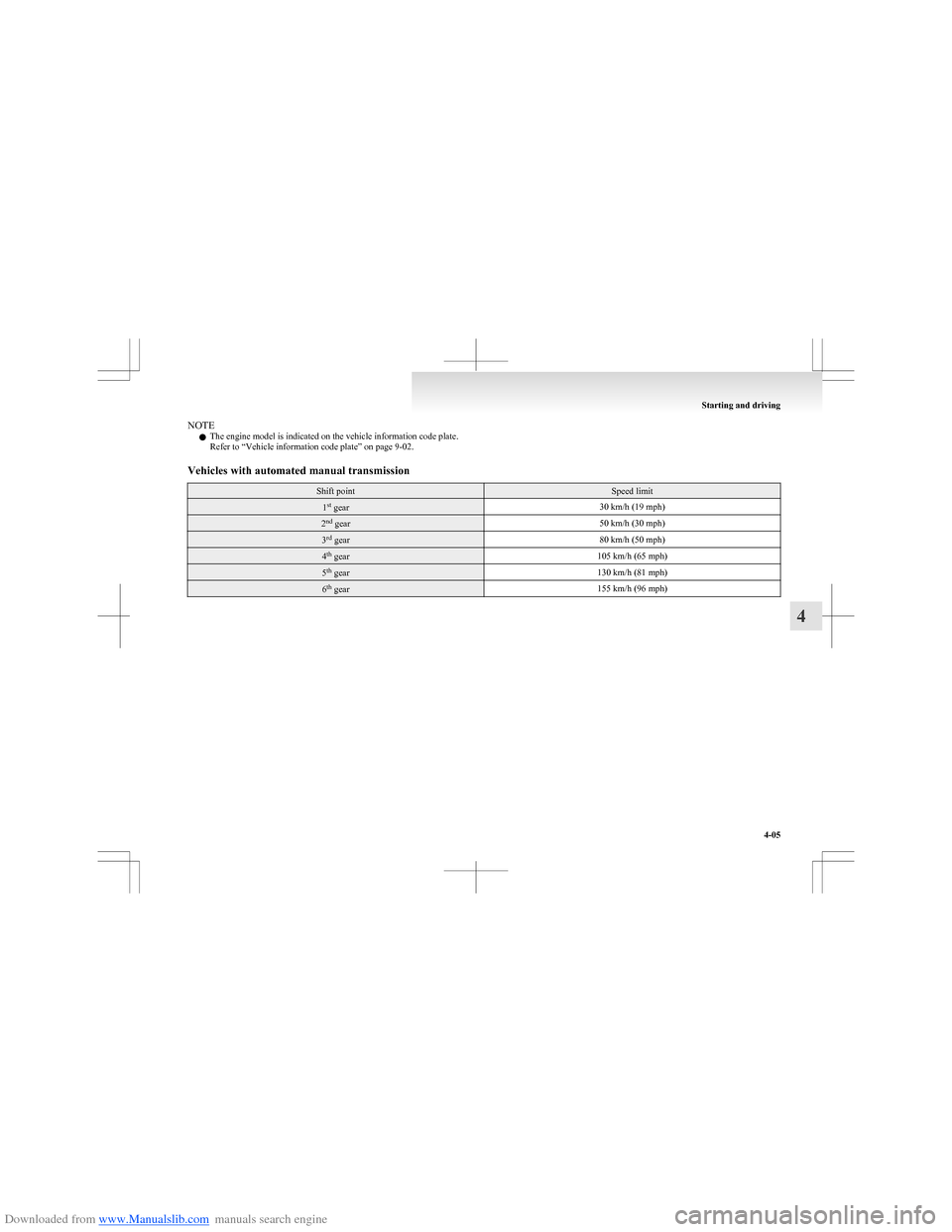
Downloaded from www.Manualslib.com manuals search engine NOTEl The engine model is indicated on the vehicle information code plate.
Refer to “Vehicle information code plate” on page 9-02.Vehicles with automated manual transmissionShift pointSpeed limit1 st
gear30 km/h (19 mph)2nd
gear50 km/h (30 mph)3rd
gear80 km/h (50 mph)4th
gear105 km/h (65 mph)5th
gear130 km/h (81 mph)6th
gear155 km/h (96 mph)
Starting and driving
4-05
4
Page 110 of 273
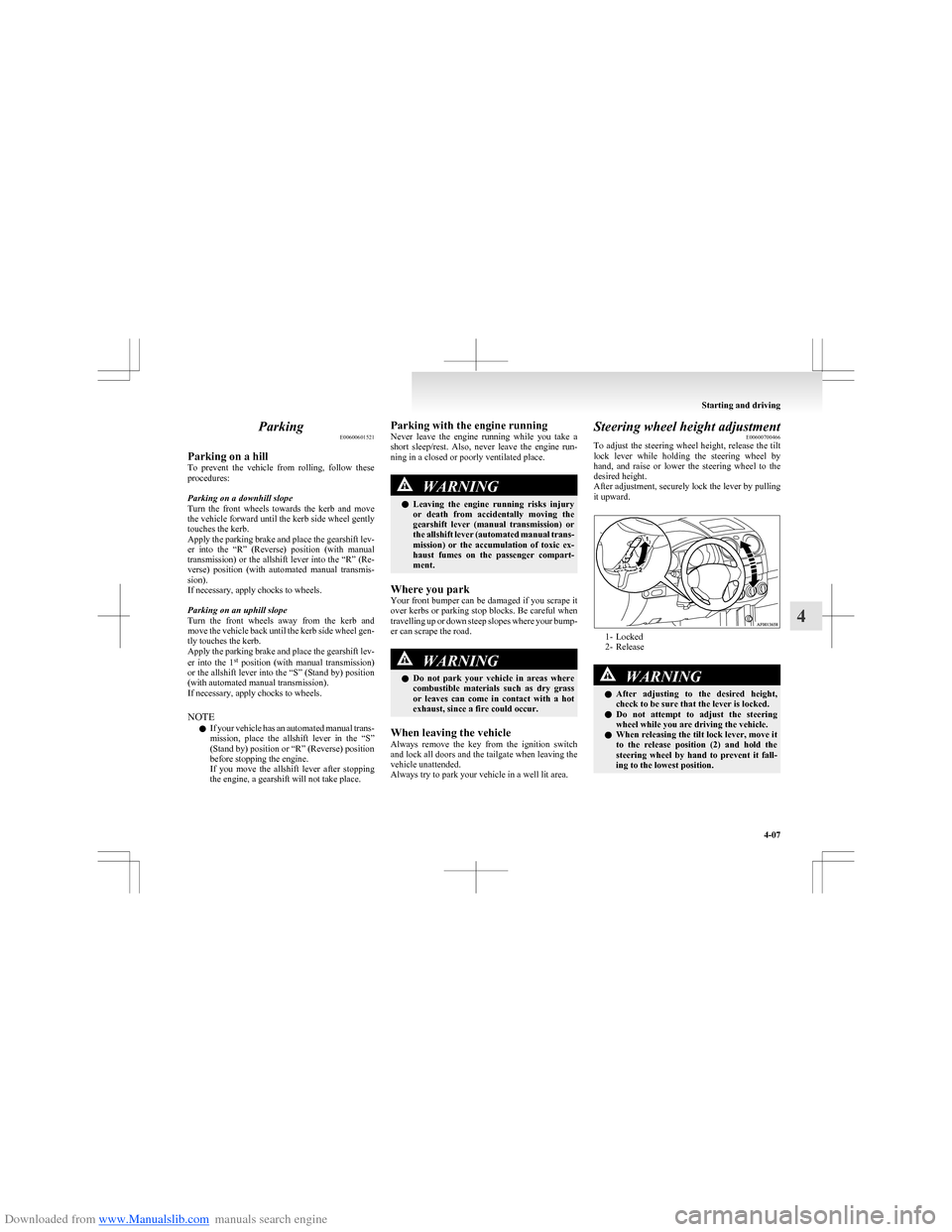
Downloaded from www.Manualslib.com manuals search engine ParkingE00600601521
Parking on a hill
To prevent the vehicle from rolling, follow these
procedures:
Parking on a downhill slope
Turn the front wheels towards the kerb and move
the vehicle forward until the kerb side wheel gently
touches the kerb.
Apply the parking brake and place the gearshift lev-
er into the “R” (Reverse) position (with manual
transmission) or the allshift lever into the “R” (Re-
verse) position (with automated manual transmis-
sion).
If necessary, apply chocks to wheels.
Parking on an uphill slope
Turn the front wheels away from the kerb and
move the vehicle back until the kerb side wheel gen-
tly touches the kerb.
Apply the parking brake and place the gearshift lev-
er into the 1 st
position (with manual transmission)
or the allshift lever into the “S” (Stand by) position
(with automated manual transmission).
If necessary, apply chocks to wheels.
NOTE l If your vehicle has an automated manual trans-
mission, place the allshift lever in the “S”
(Stand by) position or “R” (Reverse) position
before stopping the engine.
If you move the allshift lever after stopping
the engine, a gearshift will not take place.Parking with the engine running
Never leave the engine running while you take a
short sleep/rest. Also, never leave the engine run-
ning in a closed or poorly ventilated place.WARNINGl Leaving the engine running risks injury
or death from accidentally moving the
gearshift lever (manual transmission) or
the allshift lever (automated manual trans-
mission) or the accumulation of toxic ex-
haust fumes on the passenger compart-
ment.
Where you park
Your front bumper can be damaged if you scrape it
over kerbs or parking stop blocks. Be careful when
travelling up or down steep slopes where your bump-
er can scrape the road.
WARNINGl Do not park your vehicle in areas where
combustible materials such as dry grass
or leaves can come in contact with a hot
exhaust, since a fire could occur.
When leaving the vehicle
Always remove the key from the ignition switch
and lock all doors and the tailgate when leaving the
vehicle unattended.
Always try to park your vehicle in a well lit area.
Steering wheel height adjustment E00600700466
To adjust the steering wheel height, release the tilt
lock lever while holding the steering wheel by
hand, and raise or lower the steering wheel to the
desired height.
After adjustment, securely lock the lever by pulling
it upward.
1- Locked
2- Release
WARNINGl After adjusting to the desired height,
check to be sure that the lever is locked.
l Do not attempt to adjust the steering
wheel while you are driving the vehicle.
l When releasing the tilt lock lever, move it
to the release position (2) and hold the
steering wheel by hand to prevent it fall-
ing to the lowest position.
Starting and driving
4-07
4
Page 115 of 273
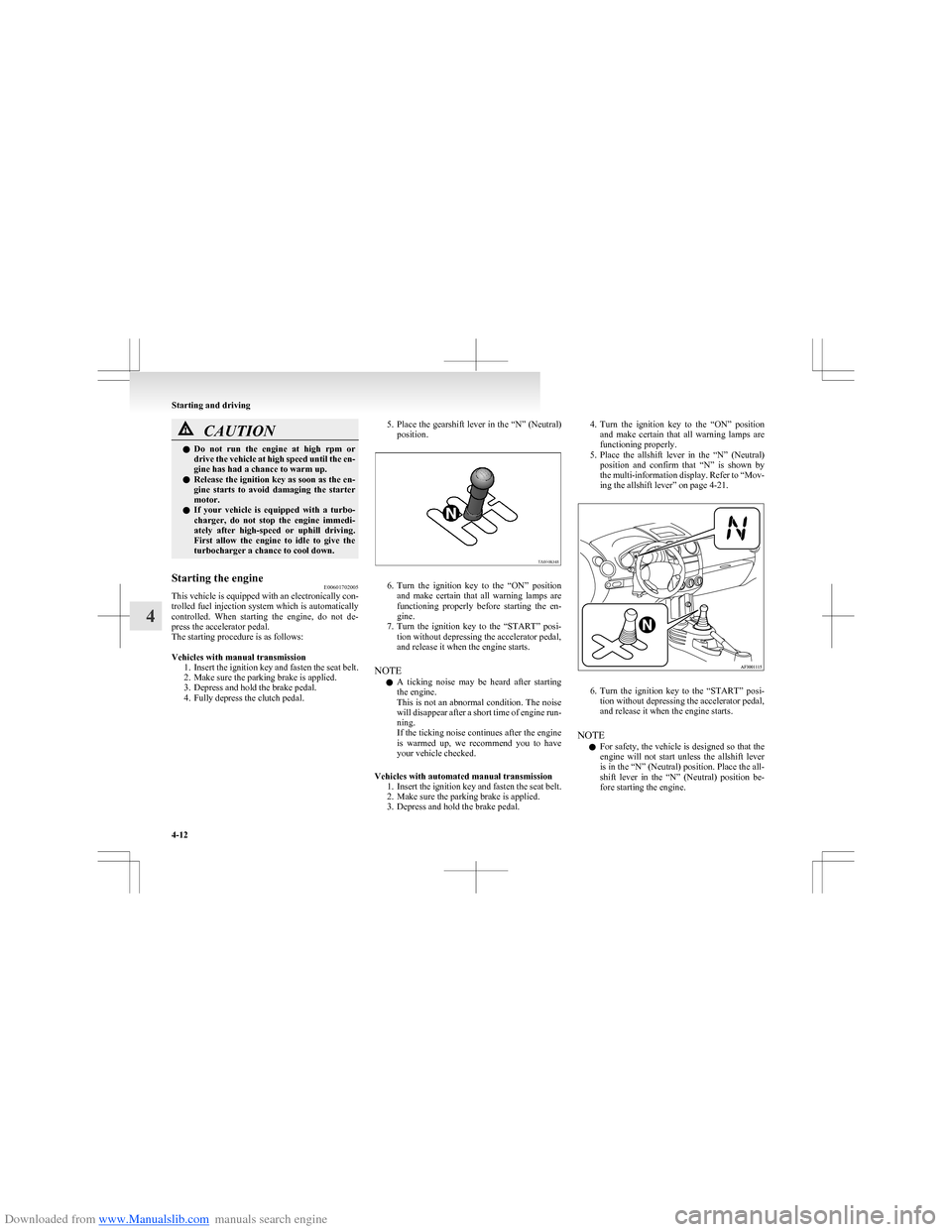
Downloaded from www.Manualslib.com manuals search engine CAUTIONlDo not run the engine at high rpm or
drive the vehicle at high speed until the en-
gine has had a chance to warm up.
l Release the ignition key as soon as the en-
gine starts to avoid damaging the starter
motor.
l If your vehicle is equipped with a turbo-
charger, do not stop the engine immedi-
ately after high-speed or uphill driving.
First allow the engine to idle to give the
turbocharger a chance to cool down.Starting the engine E00601702005
This vehicle is equipped with an electronically con-
trolled fuel injection system which is automatically
controlled. When starting the engine, do not de-
press the accelerator pedal.
The starting procedure is as follows:
Vehicles with manual transmission 1.Insert the ignition key and fasten the seat belt.
2. Make sure the parking brake is applied.
3. Depress and hold the brake pedal.
4. Fully depress the clutch pedal.
5. Place the gearshift lever in the “N” (Neutral)
position.
6. Turn the ignition key to the “ON” position
and make certain that all warning lamps are
functioning properly before starting the en-
gine.
7. Turn the ignition key to the “START” posi-
tion without depressing the accelerator pedal,
and release it when the engine starts.
NOTE l A ticking noise may be heard after starting
the engine.
This is not an abnormal condition. The noise
will disappear after a short time of engine run-
ning.
If the ticking noise continues after the engine
is warmed up, we recommend you to have
your vehicle checked.
Vehicles with automated manual transmission 1.Insert the ignition key and fasten the seat belt.
2. Make sure the parking brake is applied.
3. Depress and hold the brake pedal.
4. Turn the ignition key to the “ON” position
and make certain that all warning lamps are
functioning properly.
5. Place the allshift lever in the “N” (Neutral)
position and confirm that “N” is shown by
the multi-information display. Refer to “Mov-
ing the allshift lever” on page 4-21.
6. Turn the ignition key to the “START” posi-
tion without depressing the accelerator pedal,
and release it when the engine starts.
NOTE l For safety, the vehicle is designed so that the
engine will not start unless the allshift lever
is in the “N” (Neutral) position. Place the all-
shift lever in the “N” (Neutral) position be-
fore starting the engine.
Starting and driving
4-12
4
Page 116 of 273

Downloaded from www.Manualslib.com manuals search engine lIf you turn the ignition key to the “START”
position when the gearshift is not in the “N”
(Neutral) position, the multi-information dis-
play will behave as follows to indicate that
the engine will not start. •Gearshift in “S” (Stand by) position: An
“A” or “1” will be shown. Or “0” will flash.
• Gearshift in “R” (Reverse) position: An
“R” will be shown. Or “0” will flash.
Confirm that “N” is shown by the multi-infor-
mation display.Auto Stop & Go (AS&G) system* E00627400022
The Auto Stop & Go (AS&G) system automatical-
ly stops and restarts the engine without operating
the ignition switch when the vehicle is stopped,
such as at a traffic light or in a traffic jam, to re-
duce exhaust gases, increase fuel efficiency.CAUTIONl If the vehicle will be stopped for a long
time or if you will leave the vehicle unat-
tended, turn the ignition switch to the
“LOCK” position to stop the engine.Automatically stopping the engine E00627500010
The Auto Stop & Go (AS&G) system is automati-
cally activated when the ignition switch is turned to
the “ON” position.
You can deactivate the system by pressing the “Au-
to Stop & Go (AS&G) OFF” switch.
Refer to “To deactivate” on page 4-16. 1. Stop the vehicle.
While depressing the brake pedal, fully de-
press the clutch pedal and place the gearshift
lever in the “N” (Neutral) position.
2. Release the clutch pedal. The “” indication
lamp in the meter will illuminate and the en-
gine will stop automatically.
Starting and driving
4-13
4